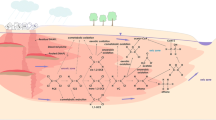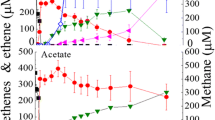Abstract.
Reductive anaerobic dehalogenation is a useful method for remediation of sites contaminated by chlorinated ethylenes, where hydrogen concentration plays the key role. Under anaerobic conditions, dehalogenating bacteria compete best against methanogenic consortia when the hydrogen level is low; and methanogenic consortia outplay dehalogenating bacteria when the hydrogen level is high. Thus, in an anaerobic mixed culture, efficient use of hydrogen for dehalogenation can be achieved by strategies that maintain hydrogen at a certain low concentration. However, due to the role of acetate, expected dehalogenating results cannot be obtained and unexpected methane formation can be encountered in practice.

Similar content being viewed by others
References
Agrawal A, Ferguson WJ, Gardner BO, Christ JA, Bandstra JZ, Tratnyek PG (2002) Effects of carbonate species on the kinetics of dechlorination of 1,1,1-trichloroethane by zero-valent iron. Environ Sci Technol 36:4326–4333
Anthony C (1988) Bacterial energy transduction. Academic Press, London
Barrio-Lage G, Parson FZ, Nassar RS, Lorenzo PA (1986) Sequential dehalogenation of chlorinated ethenes. Environ Sci Technol 20:96–99
Boone DR, Bryant MP (1980) Propionate-degrading bacterium, Syntrophobacter wolinii sp. nov. gen. nov., from methanogenic ecosystems. Appl Environ Microbiol 40:626–632
Burris DB, Campbell TJ, Manoranjan VS (1995) Sorption of trichloroethylene and tetrachloroethylene in a batch reactive metallic iron-water system. Environ Sci Technol 29:2850–2855
Cabirol N, Jacob F, Perrier J, Fouillet B, Chambon P (1998) Complete degradation of high concentration of tetrachloroethylene by a methanogenic consortium in a fixed-bed reactor. J Biotechnol 62:133–141
Chapelle FH, Haack SK, Adriaens P, Henry MA, Bradley PM (1996) Comparison of E h and H2 measurements for delineating redox processes in a contaminated aquifer. Environ Sci Technol 30:3565–3569
Clark CJ, Rao PSC, Annable MD (2003) Degradation of perchloroethylene in cosolvent solutions by zero-valent iron. J Hazard Mater 96:65–78
Distefano TD, Gossett JM, Zinder SH (1991) Reductive dechlorination of high concentrations of tetrachloroethene to ethene by an anaerobic enrichment culture in the absence of methanogenesis. Appl Environ Microbiol 57:2287–2292
Distefano TD, Gossett JM, Zinder SH (1992) Hydrogen as an electron donor for dechlorination of tetracholorethene by anaerobic mixed culture. Appl Environ Microbiol 58:3622–3629
Duhamel M, Wehr SD, Yu L, Rizvi H, Seepersad D, Dworatzek S, Cox EE, Edwards EA (2002) Comparison of anaerobic dechlorinating enrichment cultures maintained on tetrachloroethene, trichloroethene, cis-dichloroethene and vinyl chloride. Water Res 36:4193–4202
Enzien MV, Picardal FW, Hazen TC, Arnold RG, Fliermans CF (1994) Reductive dechlorination of trichloroethylene and tetrachloroethylene under aerobic conditions in a sediment column. Appl Environ Microbiol 60:2200–2204
Fennell DE, Gossett JM, Zinder SH (1997) Comparison of butyric acid, ethanol, lactic acid and propionic acid as hydrogen donors for the reductive dechlorination of tetrachloroethene. Environ Sci Technol 31:918–926
Freedman D, Gossett JM (1989) Biological reductive dechlorination of tetrachloroethylene and trichloroethylene to ethylene under methanogenic conditions. Appl Environ Microbiol 55:2144–2151
Gander JW, Parkin GF, Scherer MM (2002) Kinetics of 1,1,1-trichloroethane transformation by iron sulfide and a methanogenic consortium. Environ Sci Technol 36:4540–4546
Gao JW, Skeen RS, Hooker BS, Quesenberry RD (1997) Effects of several electron donors on tetrachloroethylene dechlorination in anaerobic soil microcosms. Water Res 31:2479–2486
Holliger C, Schraa G, Stams AJM, Zehnder AJB (1993) A highly purified enrichment culture couples the reductive dechlorination of tetrachloroethene to growth. Appl Environ Microbiol 59:2991–2997
Hwang I, Batchelor B (2000) Reductive dechlorination of tetrachloroethylene by Fe(II) in cement slurries. Environ Sci Technol 23:5017–5022
Hwang I, Batchelor B (2001) Reductive dechlorination of tetrachloroethylene in soils by Fe(II)-based degradative solidification/stabilization. Environ Sci Technol 35:3792–3797
Kao CM, Chen SC, Wang JY, Chen YL, Lee SZ (2003) Remediation of PCE-contaminated aquifer by an in situ two-layer biobarrier: laboratory batch and column studies. Water Res 37:27–38
Lampron KJ, Chiu PC, Cha DK (2001) Reductive dehalogenation of chlorinated ethenes with elemental iron: the role of microorganisms. Water Res 13:3077–3084
Lee T, Tokunaga T, Suyama A, Furukawa K (2001) Efficient dechlorination of tetrachloroethylene in soil slurry by combined use of an anaerobic Desulfitobacterium sp. strain Y-51 and zero-valent iron. J Biosci Bioeng 5:453–458
Lee WJ, Batchelor B (2003) Reductive capacity of natural reductants. Environ Sci Technol 37:535–541
Lovley DR, Phillips EJP (1987) Competitive mechanisms for inhibition of sulfate reduction and methane production in the zone of ferric iron reduction in sediments. Appl Environ Microbiol 53:2636–2641
Major DW, McMaster ML, Cox EE, Edwards EA, Dworatzek SM, Hendrickson ER, Starr MG, Payne JA, Buonamici LW (2002) Field demonstration of successful bioaugmentation to achieve dechlorination of tetrachloroethene to ethene, Environ Sci Technol 36:5106–5116
Malina JF Jr, Pohland FG (1992) Design of anaerobic processes for the treatment of industrial and municipal wastes. Technomic Publishing, Lancaster, PA
Maymó-Gatell X, Chien Y, Gossett JM, Zinder SH (1997) Isolation of a bacterium that reductively dechlorinates tetrachloroethene to ethene. Science 276:1568–1571
McInerney MJ, Bryant MP, Hespell RB, Costerton JW (1981) Syntrophomonas wolfei gen. nov. sp. nov., an anaerobic, syntrophic, fatty acid-oxidizing bacterium. Appl Environ Microbiol 41:1029–1039
Pill KG, Kupillas GE, Picardal FW, Arnold RG (1991) Estimating the toxicity of chlorinated organic compounds using a multiparameter bacterial assay. Environ Toxicol Water Qual 6:271–291
Rosner B, McCarty P, Spormann AM (1997) In vitro studies on reductive vinyl chloride dehalogenation by an anaerobic mixed culture. Appl Environ Microbiol 63:4139–4144
Sharma PK, McCarty P (1996) Isolation and characterization of a facultatively aerobic bacterium that reductively dehalogenates tetrachloroethene to cis-1,2-dichloroethene. Appl Environ Microbiol 62:761–765
Shim H, Ryoo D, Barbieri P, Wood K (2001) Aerobic degradation of mixtures of tetrachloroethylene, trichloroethylene, dichloroethylenes, and vinyl chloride by toluene-o-xylene monooxygenase of Pseudomonas stutzeri OX1. Appl Microbiol Biotechnol 56:1–5
Smatlak CR, Gossett JM, Zinder SH (1996) Comparative kinetics of hydrogen utilization for reductive dechlorination of tetrachloroethene and methanogenesis in an anaerobic enrichment culture. Environ Sci Technol 30:2850–2858
Stuart SL, Woods SL, Lemmon TL, Ingle JD Jr (1999) The effect of redox potential changes on reductive dechlorination of pentachlorophenol and the degradation of acetate by a mixed methanogenic culture. Biotechnol Bioeng 63:69–78
Vogel TM, Criddle CS, McCarty P (1987) Transformation of halogenated aliphatic compounds. Environ Sci Technol 21:719–736
Yang Y, McCarty P (1998) Competition for hydrogen within a chlorinated solvent dehalogenating anaerobic mixed culture. Environ Sci Technol 32:3591–3597
Zeikus JG (1977) The biology of methanogenic bacteria. Bacteriol Rev 41:514–541
Zinder SH, Gossett JM (1995) Reductive dechlorination of tetrachloroethene by a high rate anaerobic microbial consortium. Environ Health Perspect 103:5–7
Author information
Authors and Affiliations
Corresponding author
Rights and permissions
About this article
Cite this article
Chen, G. Reductive dehalogenation of tetrachloroethylene by microorganisms: current knowledge and application strategies. Appl Microbiol Biotechnol 63, 373–377 (2004). https://doi.org/10.1007/s00253-003-1367-7
Received:
Revised:
Accepted:
Published:
Issue Date:
DOI: https://doi.org/10.1007/s00253-003-1367-7




